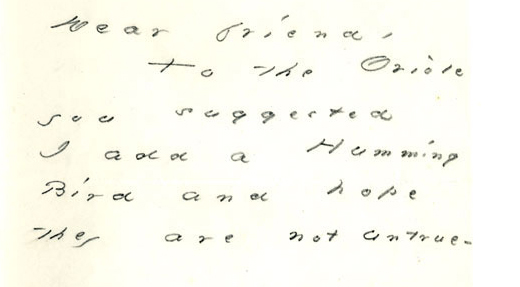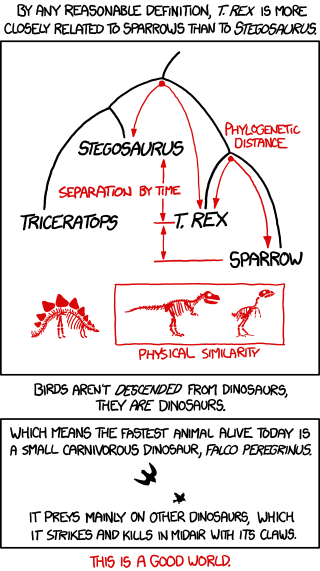In a graduate student’s paper this morning I came across a description of Emily Dickinson’s handwriting by T. W. Higginson, who in 1891 remembered receiving a letter, almost thirty years earlier, postmarked Amherst, MA. The letter was the now famous one that begins “Are you too deeply occupied to say if my verse is alive?” According to Higginson, it was in a hand
so peculiar that it seemed as if the writer might have taken her first lessons by studying the famous fossil bird-tracks in the museum of that college town. [Atlantic Monthly, 1891]
Higginson must be referring to what were the first dinosaur tracks ever discovered, turned up by a plough-boy named Pliny, in South Hadley, MA, in 1802. This was roughly 40 years before the word dinosaur was first used in print (1841), and a long time before dinosaurs were understood to be related to birds.
Obviously the marks were ancient. It stood to reason that they had been left in the mud tracts that would have formed as the diluvian waters receded.
So the markings were referred to as belonging to Noah’s raven [cf. Gen 8:7], and that’s what the slab itself came to be called–Noah’s Raven–though I doubt anyone really thought a bird left an Ark somewhere near the Euphrates and landed in S. Hadley (the concepts of plate tectonics and continental drift being a ways off themselves). On the other hand, it had to have landed somewhere, so…
By 1891, the prints were famous, largely due to Edward Hitchcock, a professor at Amherst College (later its president), who upon study decided that they belonged to giant ancient birds, and called the prints ornithichnites, coining this word in 1836: “Some of the specimens of Ornithichnites, which I regard as produced by a three toed bird, may have been made by one with four toes.” The stone and others like it became widely known as the “bird-tracks” of Amherst. [In a postscript to this story, dinosaur prints were recognized as the official state fossil of Massachusetts in 1980.]
Back to Emily Dickinson, who loved birds and who made prints on paper like bird-tracks in stone, according to Higginson. The blurb writer at the Emily Dickinson Museum suspects that as a student at Amherst Academy the young Miss Emily heard Hitchcock lecture on geological topics at Amherst College, a few blocks down the road. Hitchcock himself (and his wife) had been involved with Amherst Academy in various capacities, among his other intellectual contributions to the town. Cynthia Wolf says “Surely no thinker in [Dickinson’s] environment influenced her as much as Hitchcock.” Others think he was a source of the scientific vocabulary and geological tropes (especially volcanic ones) in some of her poems, while others still think his ideas on the relation between science and religion were important to her.
Maybe Higginson just wanted a clever way of saying something like “chicken-scratch” and the bird-tracks suggested themselves because of the Amherst connection. Compare for yourself the prints off Noah’s Raven, above, to these markings:
 What I do like about Higginson’s evocation of the bird-tracks of Amherst the idea of Dickinson’s writing as somehow like a prehistoric set of prints, left behind for future scholars to make sense of according to the prevailing taxonomies and phylogenies of the day, or else having to invent new ones to accommodate them. There is something mysterious and monumental about her writings, if not her handwriting, and the way her manuscripts have been studied (and revered) does resemble that of a rare and momentous archaeological find.
What I do like about Higginson’s evocation of the bird-tracks of Amherst the idea of Dickinson’s writing as somehow like a prehistoric set of prints, left behind for future scholars to make sense of according to the prevailing taxonomies and phylogenies of the day, or else having to invent new ones to accommodate them. There is something mysterious and monumental about her writings, if not her handwriting, and the way her manuscripts have been studied (and revered) does resemble that of a rare and momentous archaeological find.
Similarly too, just as dino prints irresistibly provoke an imaginary image of the living thing stepping across the local terrain at some impossible remove of time, these manuscripts give rise almost willy nilly to the image of a living Emily Dickinson putting words down, character by character on the page, a poem or a letter [or both, as often] taking shape in real living time, and getting stuck there for all time. Emerson said, “language is fossil poetry,” an idea that resonates in Dickinson’s talk of “loved philology”–here we have poetry as fossil writing, a metaphor that works at least as well.
All this before we get to the old turn on metrical and literal “feet.” In Dickinson’s case, I think there’s an argument to be made that these “feet” are best thought of as belonging to a bird or bird-like creature. And considering what we’ve learned about dinosaurs in the last century, maybe “Noah’s Raven” isn’t such a bad idea after all. Ponder this from XKCD:


No Comments